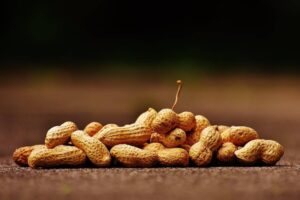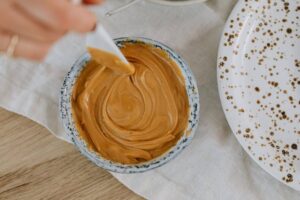Are there bugs in peanut butter? Yes, there are actually bugs in your peanut butter – but don’t worry, the FDA says it’s totally safe to eat! According to the government’s Defect Levels Handbook, there is an allowed ratio of 30 insect fragments per 100 grams of peanut butter. So next time you take a big spoonful of your favorite spread, know that a few tiny bugs are probably going along for the ride – but they’re nothing to worry about!
Did you know that the average person eats one to two pounds of flies, maggots, and other bugs annually without even knowing it, according to the Scientific American blog? But don’t worry – they’re perfectly safe to consume. In fact, the Food and Drug Administration actually permits a small number of insects in food products because it would be impossible to filter them all out. So the next time you see a bug in your food, don’t be so quick to freak out – it’s totally normal!
So what’s the deal with those bug parts in peanut butter (and other foods)? FDA regulations actually allow for insect fragments to be present in food, whether they come from pre- or post-harvesting procedures, or from processing. This means that small pieces of insects can end up in peanut butter, almond butter, and almost every kind of butter – even organic varieties.
The average serving size for peanut butter is two tablespoons, which means that each peanut butter sandwich would only have around eight insect fragments and a minuscule amount of rodent matter (!). Don’t worry though – even though there might be bugs in your peanut butter, we can help you get rid of the critters crawling around your home so you can feel comfortable and safe in your own space again.
Food Defect Action Levels set by the FDA
Recently, some stories have surfaced on the internet regarding a possible peanut butter bug infestation. I have taken the time to analyze these stories and will be sharing the truth and myths surrounding them in the blog below.

Food Defect Action Levels set by the FDA state that the percentage of bug parts in food is so low, that we can technically say there are bugs in our peanut butter, but in reality there is no need to worry about it.
If the number of rodent hairs is 1 or more per 100 grams of peanut butter, it will be deemed unsafe for human consumption, and the entire batch will be discarded. Similarly, if the quantity of gritty taste and water-insoluble inorganic residue is more than 25 mg per 100 grams of peanut butter, it will also be deemed unsafe for human consumption and the entire batch will be discarded.
Bugs in peanut butter?
It’s possible! Peanut butter is made by grinding roasted peanuts and adding a small amount of salt, sugar, and oil as stabilizers. Peanuts are a type of underground legume, and so they can be susceptible to contamination by bugs, roaches, and other insects. Therefore, it’s important to be aware that there may be bugs in your peanut butter.
While it may not be surprising to find bugs or other small organisms attached to the shells of peanuts when you first purchase them, after they’ve been properly washed, dried, and opened, the chances of finding any remaining bugs or body parts are slim to none.
Batches of peanut butter go through strict laboratory testing
All batches of peanut butter go through strict laboratory testing before they are made available to the public. Processing plants have strict protocols and laboratory tests in place to confirm and analyze the allowed bugs and their body parts per gram of peanut butter. These reports are periodically submitted to the FDA and independently researched by their laboratories to maintain the standards.

The FDA has set the limit for 30 insect fragments per 100 grams of peanut butter as anything exceeding this value is deemed unsafe for consumption. The manufacturer therefore discards any batch of peanut butter that contains more than the FDA’s suggested amount of insect fragments.
It’s unlikely that there are any whole bugs in your peanut butter, but it’s not impossible for there to be bug fragments. More bug fragments can get into your peanut butter while you are spreading it on your slice of bread before you eat it.
Organic peanut butter does contain bugs
but so does the processed kind. The difference is in the way they’re made and the ingredients used. Organic peanut butter is made from fresh peanuts and salt, without any preservatives or vegetable oil. Other than that, both types are the same.
Despite this, both types of peanut butter are made from peanuts harvested from the ground and contain bugs and their body parts. In fact, organic peanut butter usually has more bugs and body parts than processed peanut butter.
Food processing plants that create peanut butter have to follow strict regulations from the FDA, which includes enhanced surveillance, control, and laboratory tests. In short, this means that peanut butter made at home or so
-called organic peanut butter
– due to lack of testing equipment
– has more bugs and body parts than processed peanut butter. So, stop dreaming of getting bug
-free peanut butter.
Bugs in peanut butter are not known to cause any health risks

According to the hygiene hypothesis. This theory states that children who are exposed to germs early on in life have stronger immune systems than those who are not exposed. As a result, they have a lower chance of developing asthma or autoimmune diseases.
While it’s important to remember that bugs are not a health risk in peanut butter, it’s also good to know that the amount of bugs in peanut butter is limited. This way, you can be sure that you’re not eating too many bugs when you enjoy a PB&J!
Some people are allergic to peanut butter and can develop a severe rash, digestive problems, and even anaphylaxis. The allergy is actually to a protein in peanut butter and not the bugs or their body parts. If you are afraid of roaches.
Peanuts are the underground legumes of the peanut plants
As mentioned above, peanuts are the underground legumes of the peanut plants. The soil they grow in contains abundant bugs, insects, rat, bacteria, and viruses. A minuscule amount of these foreign organisms may get mixed with peanuts during processing. However, don’t worry – the chances of you actually ingesting any of these contaminants are very slim. The FDA has strict standards in place to make sure that the peanut butter we consume is safe and clean.
Peanut butter is a dietary staple for many people
You may be wondering if it’s vegan-friendly. You might be concerned that peanut butter contains crushed bugs and their body parts. However, there are so few traces of these things in peanut butter that it’s considered insignificant by the FDA and vegan groups. So you can rest assured that your PB&J is still a vegan-friendly sandwich!
Peanut butter manufacturers do their best to produce a product with as few bugs as possible, but it’s impossible to avoid them completely. Bugs are a natural part of the environment, and even the cleanest factories can’t eliminate them completely.
Eating peanut butter with crushed bugs and body parts does not violate vegan principles. Therefore, if you’re vegan and you like peanut butter, you can eat it in any amount you want. If you don’t like using insecticides and traps to kill cockroaches, you can try using natural palmetto bug repellents instead.
Final Thought
I did some research and found that the health benefits of peanut butter outweigh the health risks of not having it, because it has bugs and their body parts mixed in. So keep enjoying your meals!

